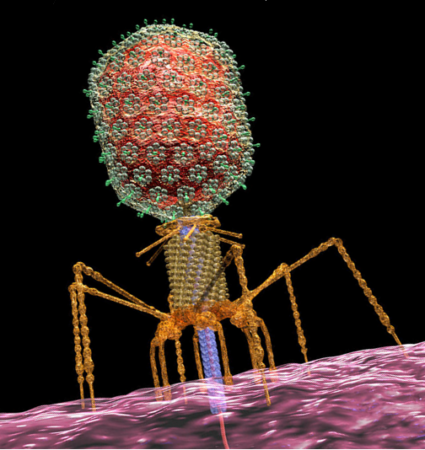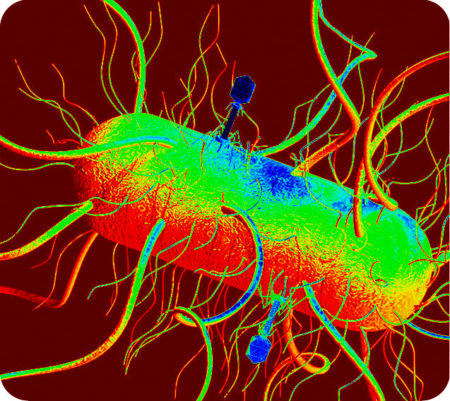A New Technology Can be Used Instead of Antibiotics to Kill Superbugs
 Dr. Timothy Lu, an associate professor in biological engineering at the Massachusetts Institute of Technology, found a new potential way to kill superbugs with a DNA editor called CRISPR-Cas9. The Wall Street Journalreported that Dr. Lu said: “is is basically a molecular scissor” that can snip bacterial genes that make bacteria drug-resistant, killing the bug in the process. The technology combines bacteriophages and CRISPR-Cas9 to target drug-resistant genes.
Dr. Timothy Lu, an associate professor in biological engineering at the Massachusetts Institute of Technology, found a new potential way to kill superbugs with a DNA editor called CRISPR-Cas9. The Wall Street Journalreported that Dr. Lu said: “is is basically a molecular scissor” that can snip bacterial genes that make bacteria drug-resistant, killing the bug in the process. The technology combines bacteriophages and CRISPR-Cas9 to target drug-resistant genes.
What is CRISPR?
CRISPR is used to edit or delete genes from living cells. “CRISPR” means Clustered Regularly Interspaced Short Palindromic Repeats. They are the characteristic of a bacterial defense system that forms the basis for CRISPR-Cas9 genome editing technology.
CRISPR-Cas9 can be programmed to target portions of genetic code and edit DNA at exact locations. It allows researchers to modify genes in living organisms permanently. This technology can be used to remove the genes that make the bacteria drug-resistant, and in the process, it can also kill the bacteria.
The New Technology to Eliminate Drug-Resistant Bacteria
Dr. Lu is studying ways to eliminate superbugs with CRISPR-Cas9. He is contemplating combining the CRISPR-Cas9 technology with bacteriophages, and engineering the bacteriophages to attack only bacteria with drug-resistant genes. They were successful in including the CRISPR-Cas9 into a bacteriophage that was designed to attack a drug-resistant E. coli (Nature Biotechnology, 2014 Sequence-specific antimicrobials using efficiently delivered RNA-guided nucleases, R. J. Citorik, M. Mmee, and T. K. Lu). The new technology has the advantage of being a more targeted approach.

Numerous hurdles need to be overcome before this technology can be used against superbugs, including the demonstration that in humans, bacteriophages are safe and effective to use. Another concern is that the CRISPR can deviate from the target, thereby slicing the wrong genes. However, there is a race among scientists to find new applications for this novel technology.
One major concern is that CRISPER can veer off target, slicing away the wrong genes with potentially harmful effects, scientists say. There are also fears of unknown effects due to the use of CRISPER to modify bacteria. Regardless of the promise of this technology, any potential therapy is years away. Nevertheless, many other scientists are trying to harness this novel technology for a variety of applications.
Can a similar technology be used in food plants to eliminate pathogenic bacteria from the environment?
Bacteriophages have been recommended for rapid detection of food-borne pathogens as well as a natural food preservative (Front Microbiol. 2016; 7: 474).Phage cocktails were created for the treatment of foods contaminated with various pathogens (Campylobacter jejuni, Cronobacter sakazakii, E. coli O157:H7, Listeria monocytogenes, Salmonella enterica, Staphylococcus aureus, and Vibrio spp). Numerous other studies report that phages may be useful for controlling specific food pathogen. However, there is no widespread use of bacteriophages to control pathogens.
Several of bacteriophage-based applications have been approved for pre-harvest control of food pathogens in livestock and poultry. Another application is the decontamination of surfaces in food-processing facilities (Neha Bhardwaj, Sanjeev K. Bhardwaj, Akash Deep, Swati Dahiya and Sanjay Kapoor, 2015. Lytic Bacteriophages as Biocontrol Agents of Foodborne Pathogens. Asian Journal of Animal and Veterinary Advances, 10: 708-723.)
Using the new advanced technology described above might improve the stability of the bacteriophages and improve their ability to attack the bacteria. As a result, it might gain more traction in the food industry.
